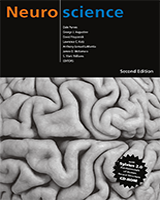From: Projections from the Basal Ganglia to Other Brain Regions

NCBI Bookshelf. A service of the National Library of Medicine, National Institutes of Health.
In 1872, a physician named George Huntington described a group of patients seen by his father and grandfather in their practice in East Hampton, Long Island. The disease he defined, which became known as Huntington's disease (HD), is characterized by the gradual onset of defects in behavior, cognition, and movement beginning in the fourth and fifth decades of life. The disorder is inexorably progressive, resulting in death within 10 to 20 years. HD is inherited in an autosomal dominant pattern, a feature that has led to a much better understanding of its cause in molecular terms.
One of the more common of the neurodegenerative diseases, HD usually presents as an alteration in mood (especially depression) or a change in character that often takes the form of increased irritability, suspiciousness, and impulsive or eccentric behavior. Defects of memory and attention may also occur. The hallmark of the disease, however, is a movement disorder consisting of rapid, jerky motions with no clear purpose; these choreiform movements may be confined to a finger or may involve a whole extremity, the facial musculature, or even the vocal apparatus. The movements themselves are involuntary, but the patient often incorporates them into apparently deliberate actions, presumably in an effort to obscure the problem. There is no weakness, ataxia, or deficit of sensory function. Occasionally, the disease begins in childhood or adolescence. The clinical manifestations in juveniles include rigidity, seizures, more marked dementia, and a rapidly progressive course.
A distinctive neuropathology is associated with these clinical manifestations: a profound but selective atrophy of the caudate and putamen, with some associated degeneration of the frontal and temporal cortices (see Figure 18.9A). This pattern of destruction is thought to explain the disorders of movement, cognition, and behavior, as well as the sparing of other neurological functions.
The availability of extensive HD pedigrees has allowed geneticists to decipher the molecular cause of this disease. HD was one of the first human diseases in which DNA polymorphisms were used to localize the mutant gene, which in 1983 was mapped to the short arm of chromosome 4. This discovery led to an intensive effort to identify the HD gene within this region by positional cloning. Ten years later, these efforts culminated in identification of the gene (named Huntingtin) responsible for the disease. In contrast to previously recognized forms of mutations such as point mutations, deletions, or insertions, the mutation of Huntingtin is an unstable triplet repeat. In normal individuals Huntingtin contains between 15 and 34 repeats, whereas the gene in HD patients contains from 42 to over 66 repeats.
HD is one of a growing number of diseases attributed to unstable DNA segments. Other examples are fragile X syndrome, myotonic dystrophy, spinal and bulbar muscular atrophy, and spinocerebellar ataxia type 1. In the latter two and HD, the repeats consist of a DNA segment (CAG) that codes for the amino acid glutamine and is present within the coding region of the gene.
The mechanism by which the increased number of polyglutamine repeats injures neurons is not clear. The leading hypothesis is that the increased numbers of glutamines alter protein folding, which somehow triggers a cascade of molecular events culminating in dysfunction and neuronal death. Interestingly, although Huntingtin is expressed predominantly in the expected neurons in the basal ganglia, it is also present in regions of the brain that are not affected in HD. Indeed, the gene is expressed in many organs outside the nervous system. How and why the mutant Huntingtin uniquely injures striatal neurons is unclear. Continuing to elucidate this molecular pathogenesis will no doubt provide further insight into this and other triplet repeat diseases.
From: Projections from the Basal Ganglia to Other Brain Regions

NCBI Bookshelf. A service of the National Library of Medicine, National Institutes of Health.